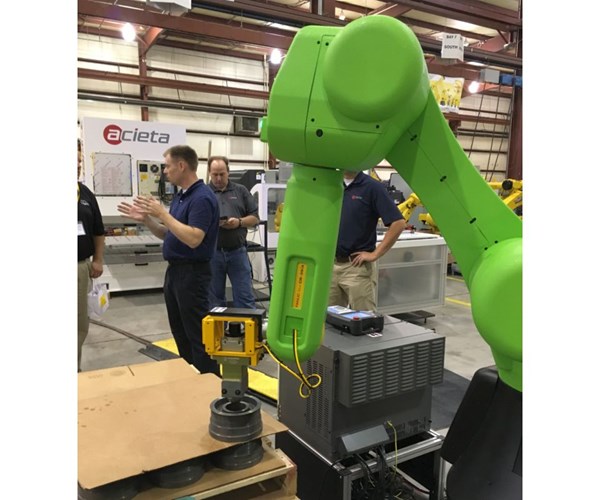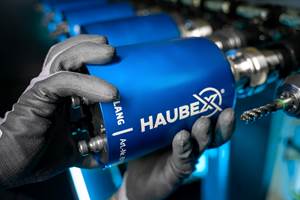Acieta Event Explores the Use and Challenges of Collaborative Robots
Speakers describe some of the considerations relevant to the category of robots that are safe for operation near people.
Share





A collaborative robot (green) ran alongside a demonstration of a fenceless robot at the automation integrator’s event. A fenceless robot uses sensors to halt the robot’s operation if a person comes too close.
One of the most significant recent developments in industrial robotics is the commercial introduction of collaborative robots. A collaborative robot (sometimes shortened to “cobot”) is a force-limited, contact-sensing robot that is safe to apply in the near and immediate presence of a human being, without guarding, because the robot will stop if it contacts a person and it will not move with enough energy to injure a person if it does make contact.
Last week, robotics integrator Acieta hosted a day-long event at its Council Bluffs, Iowa, headquarters focused on collaborative robots. Speakers represented not just Acieta but also ATI Industrial Automation, FANUC America, Schunk, Distefano Tool & Manufacturing Co. and the Robotics Industry Association.
Acieta founder John Burg described to me why it was important for the company to host this event: Manufacturers are rightly impressed with the possibilities of collaborative robots, he says, and many engineers are being urged by their management to explore a collaborative automation solution. Yet many of those applications simply do not lend themselves to a robot of this type.
Here is a recent example of an application he has seen in which a collaborative robot makes sense: A basket that is sent into heat treatment is manually loaded with parts. Various baskets have warped differently after many heat-treat cycles, so automated loading of the baskets is problematic. However, a robot lifts the basket of parts once it is full. Here, collaborative technology makes it safe and simple for a person and a robot to work on the task together.
But in a different application in which the user was initially focused on a collaborative robot, Mr. Burg says this user needed to achieve a narrow cycle time target for the productivity of the robot loading. Part of the way collaborative robots protect against injury is by moving slower than other robots have the capability of doing. And as it happened, this limited speed proved too slow to meet the needs of that application.
A presentation at the event by Schunk Regional Sales Manager Larry Bergren gave attention to another straightforward consideration relevant to collaborative robots. Namely, the gripper is not necessarily collaborative. A standard robot gripper does not offer the same responsiveness to contact that the robot itself does, he says.
Schunk has such a gripper under development and plans to introduce it soon, but the product is not ready for market yet. For now, he says, the company will offer a selection of grippers to complement collaborative robots. Grippers in this category can limit grip force, are covered in soft material and designed to limit sharp edges and pinch points, and feature a light indicating when the gripper is about to move. All of these features enable safe use near humans until the fully collaborative gripper comes.
In a different presentation, Claude Dinsmoor, general manager for material handling segment robotics with FANUC America, described some of the background of collaborative robotics as well as his view of a possible future.
This type of robot became viable for widespread industrial application in part because of an ISO standard, he says. A standard related to the safe application of industrial robots was revised in 2012 to address power- and force-limited robots. Guidance added later addressed the maximum force that different parts of the human body could acceptably experience in a contact with a moving robot. Those parameters enabled the development and introduction of robots that could be assured of not causing injury in moving contact. The result is a robot operating under very different rules than conventional robots, he says, because the latter are almost always kept segregated from humans. To note the difference, FANUC departed from its trademark yellow color in order to make its collaborative robots green.
A factor he noted is the planning this robot might create the need for, specifically because of the breadth of interaction it might have with people. The robot itself is safe to operate near a person, but how many people in the organization will have access to it? In a wide-open cell, any employee walking through the shop might step close to the robot. The entire environment this robot figures into potentially has to be evaluated for safety with this possibility in mind.
Indeed, that consideration is partly why achieving unguarded safety through collaborative robots might ultimately prove to be simply an interim step, he says. Today, a robot limited in speed and payload presents the most effective option for using robots near people. But another option already in use involves applying sensors to allow regular robots to be “fenceless.” The robot controlled in this way will slow when a person comes near, and it will stop when a person comes very close. In the future, continued advances in sensing technology might lead to even more effective fenceless robots that are safely capable of fast and highly productive use near people.

Related Content
Four-Axis Horizontal Machining Doubles Shop’s Productivity
Horizontal four-axis machining enabled McKenzie CNC to cut operations and cycle times for its high-mix, high-repeat work — more than doubling its throughput.
Read MoreHow to Accelerate Robotic Deburring & Automated Material Removal
Pairing automation with air-driven motors that push cutting tool speeds up to 65,000 RPM with no duty cycle can dramatically improve throughput and improve finishing.
Read MoreUsing the Toolchanger to Automate Production
Taking advantage of a feature that’s already on the machine tool, Lang’s Haubex system uses the toolchanger to move and store parts, making it an easy-to-use and cost-effective automation solution.
Read MoreInside the Premium Machine Shop Making Fasteners
AMPG can’t help but take risks — its management doesn’t know how to run machines. But these risks have enabled it to become a runaway success in its market.
Read MoreRead Next
Building Out a Foundation for Student Machinists
Autodesk and Haas have teamed up to produce an introductory course for students that covers the basics of CAD, CAM and CNC while providing them with a portfolio part.
Read MoreSetting Up the Building Blocks for a Digital Factory
Woodward Inc. spent over a year developing an API to connect machines to its digital factory. Caron Engineering’s MiConnect has cut most of this process while also granting the shop greater access to machine information.
Read More5 Rules of Thumb for Buying CNC Machine Tools
Use these tips to carefully plan your machine tool purchases and to avoid regretting your decision later.
Read More























.jpg;maxWidth=300;quality=90)








